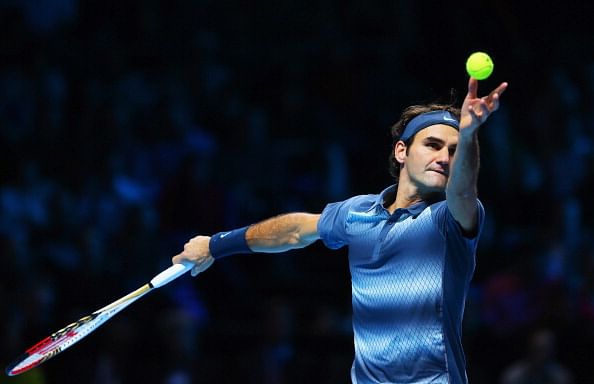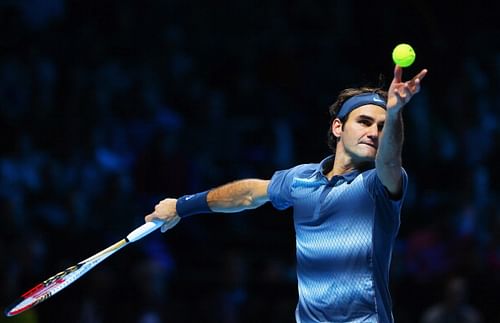
Roger Federer – The 2014 Comeback Player of the Year?

Roger Federer
Founder of ‘Big4 of Tennis’
From 2004 to 2010, Roger Federer and Rafael Nadal ruled at the peak of the tennis world, making it an exclusive top2 club. Novak Djokovic’s domination at the top in 2011 made it the big3 of tennis. Then in 2012, Andy Murray finally broke his grand slam duck and that group became the big4. The term continued to be part of tennis parlance in 2013.
As players get their well-deserved break towards the end of 2013, TV channels telecast reruns of old matches and bored tennis fans eagerly anticipate the start of 2014 tennis season; one can’t help resist the thought that next year is going to be more crucial for Roger Federer than others in this elite group. It would have seemed unthinkable a year ago but now the question has to be asked if the founder of this group is going to be able to retain his membership 12 months from now.
2013 review
Roger started 2013 reasonably well at Australian open, defeating the likes of Raonic and Tsonga en route to another semifinal where he lost to Murray in 5 sets. While he had some disappointing losses in the first half of the year (such as to Julien Benneteau at Rotterdam and to Kei Nishikori at Madrid), he continued to notch a number of wins and compete at the highest level. He lost to Tsonga in the quarters of French but in the process extended his record of consecutive grand slam quarter final appearances to an incredible 36. He came back strongly from that defeat to win the title at Halle.
All was still well. Federer was still ranked in top3. Then came the jolt. Out of nowhere. At Wimbledon, he lost to world number 116 Sergiy Stakhovsky in the second round. He then lost to Federico Delbonis, another player outside top 100 at 114, in the next tournament he played. The losing streak continued into the following tournament where he lost to David Brands ranked 55. The lean form continued through to the US open where he lost in the round of 16.
Suddenly things weren’t the same any more. It was a full blown crisis. Federer wasn’t just not winning tournaments any more but he was losing in early rounds and losing to players ranked outside top 50 and even top 100. His ranking slipped to outside 4 for the first time since 2003 and went as low as 7.
The decline in form and the loss of confidence was so sudden that it took everyone by surprise. People didn’t realize what was wrong. Was it his troublesome back which he later talked about but then don’t we all expect Roger to do better, back niggle or not? Was it the new racquet that contributed to some of the losses after Wimbledon but then what happened at his favourite All England grass surface? Was it his age finally catching up with him but he was still only 31 and old age doesn’t catch up in a matter of weeks, does it? Was it his movement, as Novak thought, either hampered by his back injury or slowed as a result of aging? Was it his ability to stay calm in big pressure moments that started to wane just a little? Or was it a combination of some or all of these factors?
None knew the answer, not completely anyway. People tried to explain the best they could but they all essentially waited for a response. And it came. Slowly but surely. At his hometown tournament in Basel he reached the final making sure he will be competing in the prestigious year end event. In London, he scored wins over Gasquet and Del Potro and competed well with Djokovic and Nadal although he lost to both of them.
The good news for Roger’s fans was that he showed significant progress towards a comeback to fitness, form and confidence during those two weeks. He still showed inconsistency for certain periods during matches and a lack of confidence at times but he also showed a willingness to fight harder than he is used to and a willingness to change strategy when it wasn’t working. Some great volleys at the net and some deft drop shots on the slow centre court of the O2 arena were delightful examples of changing tactics. So was the decision to part ways with his coach.
Looking ahead
Roger has been many things to tennis. He has been the winner of most grand slams in history, has been arguably the greatest player of all time and one of the most graceful players across all eras. He has won the Stefan Edberg sportsmanship award 9 times, Fans’ Favorite award 11 consecutive times and the Arthur Ashe Humanitarian Award twice. He never had to worry about winning the Comeback Player of the Year award but if he wants to fulfill his desire to play at the next Olympic Games at Rio, a comeback is exactly what he has to produce.
Mark Philippoussis, for one, thinks Roger can win one more grand slam and that it has to be in 2014 if that has to happen. While I am not sure about the first part of his prophecy (I think he can win more than one or can end up at his current list of 17) but am more inclined to agree with Mark on the second part that if Roger is to mount a strong comeback, 2014 is where it begins. After all, won’t we all like to see Roger competing in the final weekend of grand slams and at the year-end World Tour finals for some more time to come?